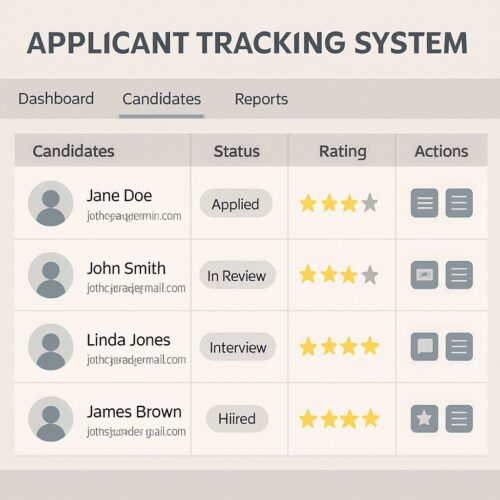In today’s competitive job market, finding the right candidate for a position can be a daunting task. This is where ATS systems, or Applicant Tracking Systems, come into play. These powerful tools help streamline the recruitment process, making it easier for HR professionals to manage applications and track candidates throughout the hiring process. In this comprehensive guide, we will explore everything you need to know about ATS systems, including their types, benefits, and how to choose the best one for your needs.
An Applicant Tracking System (ATS) is a software application that helps organizations manage their recruitment and hiring processes. It automates the process of tracking, evaluating, and managing job applications, making it easier for HR teams to find the best candidates for their open positions. With the rise of digital recruitment, ATS systems have become an essential tool for companies looking to streamline their hiring process and improve their recruitment analytics.

Benefits of Using an ATS
Using an ATS system can provide numerous benefits for your organization. Let’s take a closer look at some of the key advantages:
Improved Efficiency
ATS systems automate many time-consuming tasks in the recruitment process, such as sorting through resumes and tracking candidate progress. This frees up valuable time for HR professionals, allowing them to focus on more strategic tasks like interviewing and decision-making.
Enhanced Candidate Experience
A well-implemented ATS system can improve the candidate experience by providing a seamless and transparent application process. Candidates can easily track their application status and receive timely updates, which helps keep them engaged and reduces the likelihood of them dropping out of the process.
Better Data Management
ATS systems centralize all candidate information in one place, making it easier for recruiters to access and analyze data. This not only helps in making more informed hiring decisions but also provides valuable insights into recruitment trends and performance.
Increased Collaboration
Many ATS systems offer collaboration features that allow HR teams to work together more effectively. Recruiters can share candidate profiles, leave feedback, and communicate easily within the platform, ensuring everyone is on the same page throughout the hiring process.

Types of Applicant Tracking Systems
There are several types of ATS systems available, each designed to cater to different organizational needs. Here are some of the most popular types:
Standalone ATS
A standalone ATS is a dedicated software solution specifically designed for applicant tracking. It focuses solely on managing the recruitment process and typically offers a wide range of features tailored to the needs of hiring teams. These systems are ideal for organizations that require advanced recruitment capabilities and prefer a specialized solution.
Integrated ATS
An integrated ATS is part of a larger HR software suite, such as a Human Resource Management System (HRMS) or Human Capital Management (HCM) platform. These systems offer a comprehensive approach to managing various HR functions, including recruitment, payroll, and employee management. Integrated ATS solutions are suitable for organizations looking for an all-in-one HR solution.
Cloud-Based ATS
Cloud-based ATS systems are hosted on remote servers and accessed via the internet. They offer several advantages, such as easy implementation, scalability, and remote access. Cloud-based solutions are ideal for organizations that require flexibility and want to minimize their IT infrastructure costs.
On-Premise ATS
On-premise ATS systems are installed and maintained on a company’s local servers. These solutions provide greater control over data security and customization but may require significant IT resources for implementation and maintenance. On-premise ATS systems are suitable for organizations with specific security or compliance requirements.
Top-Rated Applicant Tracking Systems
With so many ATS systems available, it can be challenging to choose the best one for your organization. Here are some top-rated applicant tracking systems that have gained popularity among HR professionals:
1. recruitChamp
recruitChamp is a highly efficient, customizable ATS designed to meet the diverse needs of growing organizations. It stands out for its AI-powered candidate screening, mobile-friendly interface, and customizable workflows, which help streamline the recruitment process. recruitChamp also includes advanced reporting capabilities to track hiring performance, CRM tools for building candidate relationships, and seamless integration with other HR tools, making it an all-in-one solution for modern recruitment needs. Additionally, its diversity and inclusion features ensure that companies can track and enhance their D&I efforts throughout the hiring process.
2. Greenhouse
Greenhouse is a powerful ATS that focuses on providing a structured and data-driven approach to recruitment. It offers a wide range of features, including interview scheduling, candidate scorecards, and robust analytics. Greenhouse is known for its intuitive interface and strong integration capabilities.
3. Lever
Lever is a user-friendly ATS that emphasizes collaboration and communication among hiring teams. It offers features such as customizable pipelines, automated workflows, and advanced reporting. Lever’s seamless integration with popular tools like Slack and LinkedIn makes it a popular choice for growing companies.
4. BambooHR
BambooHR is a comprehensive HR software suite that includes an integrated ATS. It offers features such as job posting, applicant tracking, and onboarding. BambooHR’s user-friendly interface and strong customer support make it a popular choice among small to mid-sized businesses.
How to Choose the Best ATS System for Your Needs
Selecting the right ATS system for your organization can significantly impact your recruitment success. Here are some factors to consider when evaluating different ATS options:
Features
Identify the key features your organization needs in an ATS, such as resume parsing, candidate tracking, and integration capabilities. Make sure the system you choose offers the functionality required to support your recruitment process.
Scalability
Choose an ATS system that can grow with your organization. Look for solutions that offer flexible pricing plans and the ability to add or remove features as your needs change.
Usability
An intuitive and user-friendly interface is essential for ensuring your team can effectively use the ATS system. Look for solutions that offer a clean design and easy navigation to minimize the learning curve.
Integration
Ensure the ATS system you choose can seamlessly integrate with your existing HR tools and platforms. This will help streamline your recruitment process and reduce the need for manual data entry.
Support
Choose a provider that offers reliable customer support and resources to help you get the most out of your ATS system. This can include training, documentation, and troubleshooting assistance.
Conclusion
ATS systems play a crucial role in modern recruitment processes, helping organizations efficiently manage applications and track candidates. By understanding the different types of ATS systems and considering your organization’s specific needs, you can select the best solution to enhance your recruitment efforts and improve overall hiring success. Whether you’re a small business or a large enterprise, investing in a top-rated applicant tracking system can make a significant difference in your ability to attract and retain top talent.

